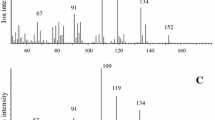Abstract
The cDNA of a marine fish microsomal epoxide hydrolase (mEH) gene from Mugil cephalus was cloned by rapid amplification of cDNA ends (RACE) techniques. The homology model for the mEH of M. cephalus showed a characteristic structure of α/β-hydrolase-fold main domain with a lid domain over the active site. The characteristic catalytic triad, consisting of Asp(238), His(444), and Glu(417), was highly conserved. The cloned mEH gene was expressed in Escherichia coli and the recombinant mEH exhibited (R)-preferred hydrolysis activity toward racemic styrene oxide. We obtained enantiopure (S)-styrene oxide with a high enantiopurity of more than 99% enantiomeric excess and yield of 15.4% by batch kinetic resolution of 20 mM racemic styrene oxide.







Similar content being viewed by others
References
Arand M, Wagner H, Oesch F (1996) Asp(333), Asp(495), and His(523) form the catalytic triad of rat soluble epoxide hydrolase. J Biol Chem 271:4223–4229
Archelas A, Furstoss R (2001) Synthetic applications of epoxide. Curr Opin Chem Biol 5:112–119
de Vries EJ, Janssen DB (2003) Biocatalytic conversion of epoxides. Curr Opin Biotechnol 14:414–420
Gong P-F, Xu J-H (2005) Bio-resolution of a chiral epoxide using whole cells of Bacillus megaterium ECU1001 in a biphasic system. Enzyme Microb Technol 36:252–257
Kasai N, Suzuki T, Furukawa Y (1998) Chiral C3 epoxides and halohydrins: their preparation and synthetic application. J Mol Catal B Enzym 4:237–252
Kim HS, Lee SJ, Lee EJ, Hwang JW, Park S, Kim SJ, Lee EY (2005) Cloning and characterization of a fish microsomal epoxide hydrolase of Danio rerio and application to kinetic resolution of racemic styrene oxide. J Mol Catal B Enzym 37:30–35
Kim HS, Lee SJ, Lee EY (2006) Development and characterization of recombinant whole-cell biocatalysts expressing epoxide hydrolase from Rhodotorula glutinis for enantioselective resolution of racemic epoxides. J Mol Catal B Enzym (in press)
Lee JW, Lee EJ, Yoo SS, Park S, Kim HS, Lee EY (2003) Enantioselective hydrolysis of racemic styrene oxide by epoxide hydrolase of Rhodosporidium kratochvilovae SYU-08. Biotechnol Bioprocess Eng 8:306–308
Lee EY, Yoo S-S, Kim HS, Lee SJ, Oh Y-K, Park S (2004) Production of (S)-styrene oxide by recombinant Pichia pastoris containing epoxide hydrolase from Rhodotorula glutinis. Enzyme Microb Technol 35:624–631
Liu Z, Michel J, Wang Z, Witholt B, Li Z (2006) Enantioselective hydrolysis of styrene oxide with the epoxide hydrolase of Sphingomonas sp. HXN-200. Tetrahedron Asymmetry 17:47–52
Monterde MI, Lombard M, Archelas A, Cronin A, Arand M, Furstoss R (2004) Enzymatic transformations. Part 58: enantioconvergent biohydrolysis of styrene oxide derivatives catalysed by the Solanum tuberosum epoxide hydrolase. Tetrahedron Asymmetry 15:2801–2805
Morisseau C, Hammock BD (2005) Epoxide hydrolases: mechanisms, inhibitor designs, and biological roles. Annu Rev Pharmacol Toxicol 45:311–333
Nardini M, Ridder IS, Rozeboom HJ, Kalk KH, Rink R, Janssen DB, Dijkstra BW (1999) The X-ray structure of epoxide hydrolase from Agrobacterium radiobacter AD1. J Biol Chem 274:14579–14596
Newman J, Morisseau WC, Hammock BD (2005) Epoxide hydrolases: their roles and interactions with lipid metabolism. Prog Lipid Res 44:1–51
Seidegard J, Ekstrom G (1997) The role of human glutathione transferases and epoxide hydrolases in the metabolism of xenobiotics. Environ Health Perspect 105: 791–799
Steinreiber A, Faber K (2001) Microbial epoxide hydrolases for preparative biotransformations. Curr Opin Biotechnol 12:552–558
Visser H, Weijers CAGM, van Ooyen AJJ, Verdoes JC (2002) Cloning, characterization and heterologous expression of epoxide hydrolase-encoding cDNA sequences from yeasts belonging to the genera Rhodotorula and Rhodosporidium. Biotechnol Lett 24:1687–1694
Weijers CA, Meeuwse P, Herpers RL, Franssen MC, Sudholter EJ (2005) Stereoselectivity and substrate specificity in the kinetic resolution of methyl-substituted 1-oxaspiro[2.5]octanes by Rhodotorula glutinis epoxide hydrolase. J Org Chem 70:6639–6646
Yamada T, Morisseau C, Maxwell JE, Argiriadi MA, Christianson DW, Hammock BD (2000) Biochemical evidence for the involvement of tyrosine in epoxide activation during the catalytic cycle of epoxide hydrolase. J Biol Chem 275:23082–23088
Zou J, Hallberg BM, Bergfors T, Oesch F, Arand M, Mowbray SL, Jones TA (2000) Structure of Aspergillus niger epoxide hydrolase at 1.8 Å resolution: implication for the structure and function of the mammalian microsomal class of epoxide hydrolases. Structure 8:111–122
Acknowledgement
This work was supported by the Marine and Extreme Genome Research Center Program, Ministry of Marine Affairs and Fisheries, Republic of Korea. Professor E. Y. Lee as a visiting scholar at Cornell University was financially supported by LG Yeonam Foundation via Oversea Professor Program and Kyungsung University.
Author information
Authors and Affiliations
Corresponding author
Rights and permissions
About this article
Cite this article
Lee, S.J., Kim, H.S., Kim, S.J. et al. Cloning, expression and enantioselective hydrolytic catalysis of a microsomal epoxide hydrolase from a marine fish, Mugil cephalus . Biotechnol Lett 29, 237–246 (2007). https://doi.org/10.1007/s10529-006-9222-4
Received:
Revised:
Accepted:
Published:
Issue Date:
DOI: https://doi.org/10.1007/s10529-006-9222-4




